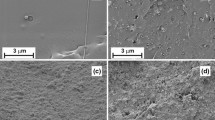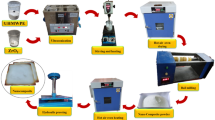Abstract
The application of bioresorbable polymer nanocomposites in orthopaedics offer the potential to address several of the limitations associated with the use of metallic implants. Their enhanced biological performance has been demonstrated recently, but until now relatively little work has been reported on their mechanical properties. To this end, the viscoelastic properties and Tg of bioresorbable polylactide-co-glycolide/α-tricalcium phosphate nanocomposites were investigated by dynamic mechanical thermal analysis. At room temperature of approximately 20°C, the storage moduli of the nanocomposites were generally higher than the storage modulus of the unfilled polymer due to the stiffening effect of the nano-particles. However at physiological temperature of approximately 37°C, the storage moduli of the nanocomposites decreased from 6.2 to 15.4% v/v nano-particle loadings. Similarly the Tg of the nanocomposites also decreased from 6.2 to 15.4% v/v nano-particle loadings. These effects were thought to be due to weak interfacial bonding between the nano-particles and polymer matrix. The storage moduli at 37°C and Tg increased from the minimum value when the particle loading was raised to 25.7 and 34.2% v/v loadings. SEM and particle size distribution histograms showed that at these loadings, there was a broad particle size distribution consisting of nano-particles and micro-particles and that some particle agglomeration was present. The consequent reduction in the interfacial area and the number of weak interfaces presumably accounts for the rise in the storage modulus at 37°C and the Tg.








Similar content being viewed by others
References
Rezwan K, Chen QZ, Blaker JJ, Boccaccini AR. Biodegradable and bioactive porous polymer/inorganic composite scaffolds for bone tissue engineering. Biomaterials. 2006;27:3413–31.
Yang ZJ, Best SM, Cameron RE. The Influence of alpha-tricalcium phosphate nanoparticles and microparticles on the degradation of poly(d,l-lactide-co-glycolide). Adv Mater. 2009;21:3900–4.
Ehrenfried LM, Patel MH, Cameron RE. The effect of tri-calcium phosphate (TCP) addition on the degradation of polylactide-co-glycolide (PLGA). J Mater Sci Mater Med. 2008;19:459–66.
Yang Z, Thian ES, Brooks RA, Rushton N, Best SM, Cameron RE. Apatite formation on alpha-tricalcium phosphate/poly (d,l-lactide-co-glycolide) nanocomposite. Bioceramics. 2008;361–363:459–62.
Ji BH, Gao HJ. Mechanical properties of nanostructure of biological materials. J Mech Phys Solids. 2004;52:1963–90.
Jose MV, Thomas V, Johnson KT, Dean DR, Nyalro E. Aligned PLGA/HA nanofibrous nanocomposite scaffolds for bone tissue engineering. Acta Biomater. 2009;5:305–15.
Wu TM, Liu CY. Poly(ethylene 2, 6-naphthalate)/layered silicate nanocomposites: fabrication, crystallization behavior and properties. Polymer. 2005;46:5621–9.
Chen DZ, Tang CY, Chan KC, Tsui CP, Yu PHF, Leung MCP, et al. Dynamic mechanical properties and in vitro bioactivity of PHBHV/HA nanocomposite. Compos Sci Technol. 2007;67:1617–26.
Ash BJ, Siegel RW, Schadler LS. Mechanical behavior of alumina/poly(methyl methacrylate) nanocomposites. Macromolecules. 2004;37:1358–69.
Khan AN, Hong PD, Chuang WT, Shih KS. Effect of uniaxial drawing on the structure and glass transition behavior of poly(trimethylene 2,6-naphthalate)/layered clay nanocomposites. Polymer. 2009;50:6287–96.
Ash BJ, Siegel RW, Schadler LS. Glass-transition temperature behavior of alumina/PMMA nanocomposites. J Polym Sci B Polym Phys. 2004;42:4371–83.
Liu FK, Hsieh SY, Ko FH, Chu TC. Synthesis of gold/poly(methyl methacrylate) hybrid nanocomposites. Colloids Surf A Physicochem Eng Asp. 2003;231:31–8.
Ash BJ, Schadler LS, Siegel RW. Glass transition behavior of alumina/polymethylmethacrylate nanocomposites. Mater Lett. 2002;55:83–7.
Arrighi V, McEwen IJ, Qian H, Prieto MBS. The glass transition and interfacial layer in styrene-butadiene rubber containing silica nanofiller. Polymer. 2003;44:6259–66.
Wang T, Feng Z. Dynamic mechanical properties of cortical bone: The effect of mineral content. Mater Lett. 2005;59:2277–80.
Yang Z, Thian ES, Best SM, Cameron RE. A novel way of dispersing fine ceramic particles in PLGA matrix. Bioceramics. 2007;330–332:511–4.
Van de Velde K, Kiekens P. Biopolymers: overview of several properties and consequences on their applications. Polym Test. 2002;21:433–42.
Mathew M, Schroeder LW, Dickens B, Brown WE. Crystal-structure of alpha-Ca3(PO4)2. Acta Crystallogr B Struct Sci. 1977;33:1325–33.
Wu DF, Wu LA, Wu LF, Zhang M. Rheology and thermal stability of polylactide/clay nanocomposites. Polym Degrad Stab. 2006;91:3149–55.
Ogata N, Jimenez G, Kawai H, Ogihara T. Structure and thermal/mechanical properties of poly(l-lactide)-clay blend. J Polym Sci B Polym Phys. 1997;35:389–96.
Chang JH, An YU, Sur GS. Poly(lactic acid) nanocomposites with various organoclays. I. Thermomechanical properties, morphology, and gas permeability. J Polym Sci B Polym Phys. 2003;41:94–103.
Sen S, Thomin JD, Kumar SK, Keblinski P. Molecular underpinnings of the mechanical reinforcement in polymer nanocomposites. Macromolecules. 2007;40:4059–67.
Zhu ZY, Thompson T, Wang SQ, von Meerwall ED, Halasa A. Investigating linear and nonlinear viscoelastic behavior using model silica-particle-filled polybutadiene. Macromolecules. 2005;38:8816–24.
Pryamitsyn V, Ganesan V. Origins of linear viscoelastic behavior of polymer-nanoparticle composites. Macromolecules. 2006;39:844–56.
Murugan R, Ramakrishna S. Development of nanocomposites for bone grafting. Compos Sci Technol. 2005;65:2385–406.
Park PIP, Jonnalagadda S. Predictors of glass transition in the biodegradable polylactide and poly-lactide-co-glycolide polymers. J Appl Polym Sci. 2006;100:1983–7.
Acknowledgements
Samuel I. J. Wilberforce is grateful to his partner, Ms. Charlotte Fay von Karsa, for funding his PhD studies. The authors thank DSM Xplore for the use of their mini injection moulding machine. The authors also thank Prof. William Clegg of Cambridge University’s Materials Science and Metallurgy department for the use of his attritor milling machine. Samuel I. J. Wilberforce is grateful for the support of Dr. Jenny Shepherd, Mr. David Shepherd, Mr. Rob Cornell and Mr. Simon Griggs also of Cambridge University’s Materials Science and Metallurgy department during experiments. The authors are also grateful for the support of Mr. Jon Rickard of the Cavendish Laboratory, Department of Physics, University of Cambridge for his support during the SEM experiments.
Author information
Authors and Affiliations
Corresponding author
Rights and permissions
About this article
Cite this article
Wilberforce, S.I.J., Best, S.M. & Cameron, R.E. A dynamic mechanical thermal analysis study of the viscoelastic properties and glass transition temperature behaviour of bioresorbable polymer matrix nanocomposites. J Mater Sci: Mater Med 21, 3085–3093 (2010). https://doi.org/10.1007/s10856-010-4170-x
Received:
Accepted:
Published:
Issue Date:
DOI: https://doi.org/10.1007/s10856-010-4170-x




